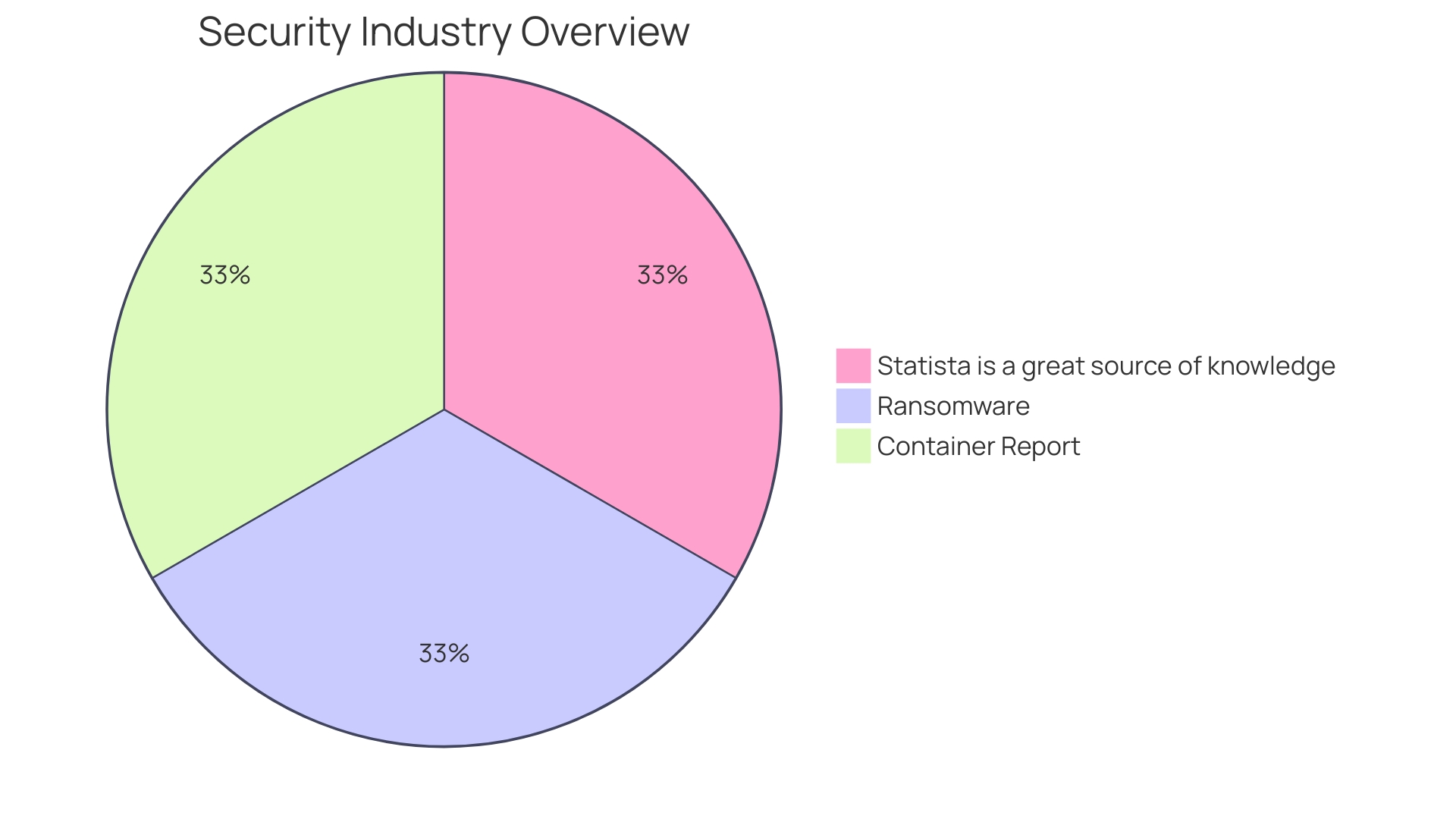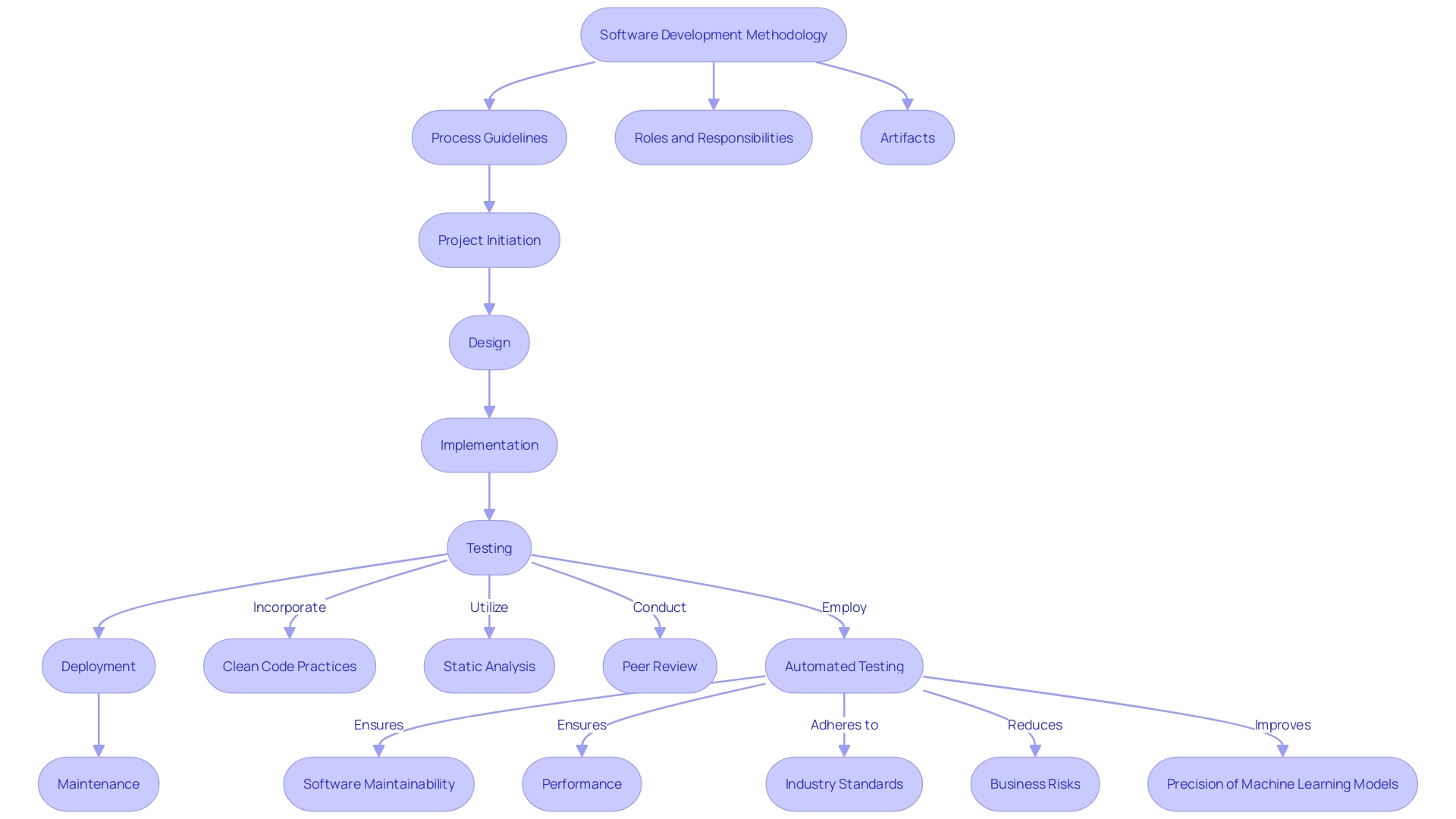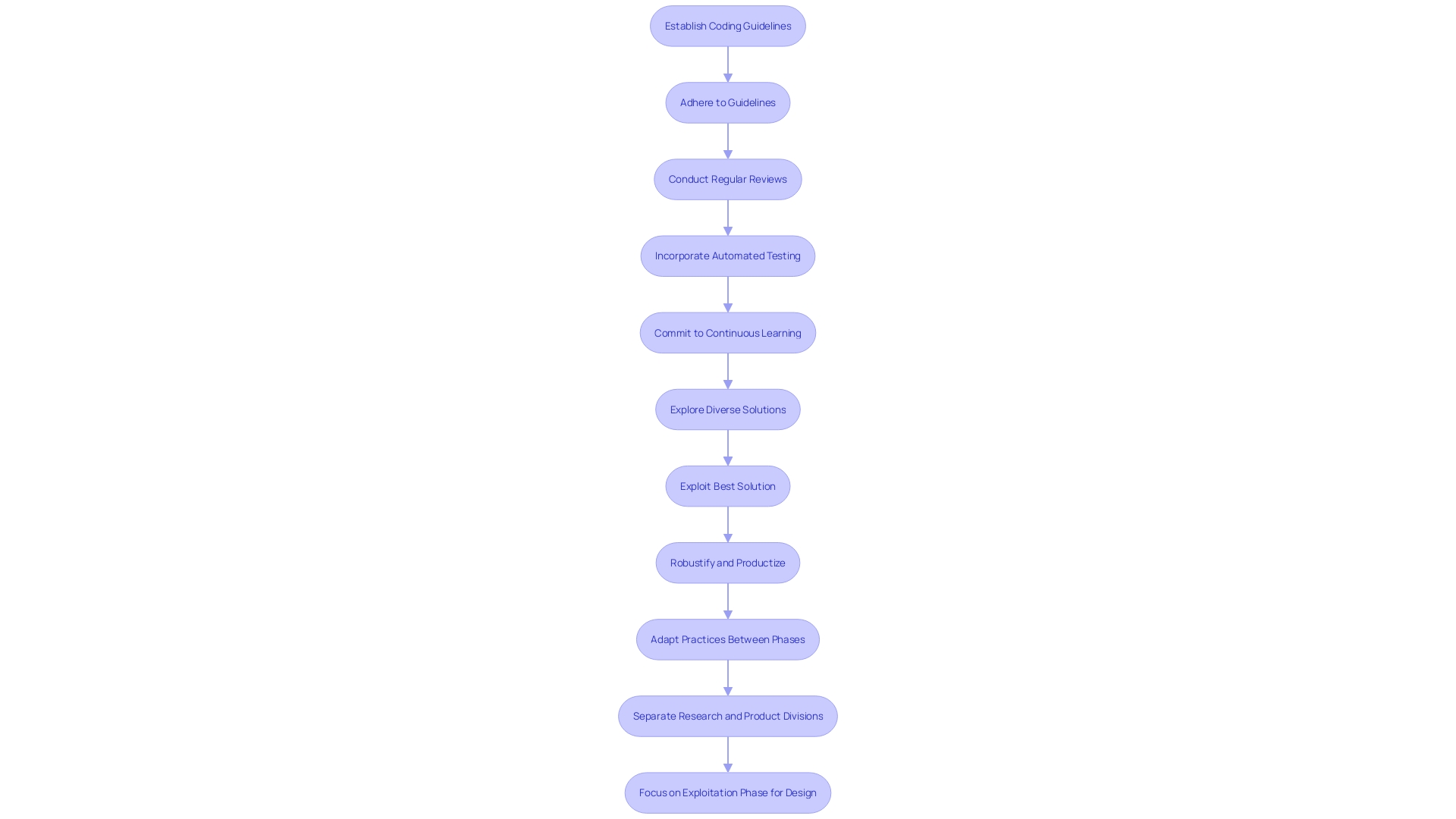Introduction
In the current digital era, ensuring the integrity and functionality of software has become crucial. With potential pitfalls that can compromise code quality, rigorous quality assurance (QA) processes are essential. This article explores the importance of code quality assurance, the benefits it brings, various techniques to achieve it, and best practices to follow.
From the banking sector's push towards digitalization to the adoption of AI in software development, the landscape poses new challenges that necessitate efficient QA methods. By adhering to quality standards and implementing robust testing methodologies, software teams can enhance efficiency, reliability, and maintainability. Join us as we delve into the world of code quality assurance and discover how it can elevate your software development process.
Understanding Code Quality Assurance
Ensuring the integrity and functionality of applications is of utmost importance in the current digital era, where technology supports our daily activities and the global economy. The development life cycle is laden with potential pitfalls that can compromise code quality, which is why rigorous quality assurance (QA) processes are essential. QA is a diverse approach that combines development and testing to create a product that fulfills its purpose and adheres to the highest levels of performance, security, and reliability.
M&T Bank, with its significant history and scale, illustrates the enormous stakes involved in this process. As the banking sector propels towards digitalization, it faces immense pressure to maintain the utmost security and regulatory compliance, given the sensitivity of financial data. Flawed software not only risks security breaches and financial losses but can also tarnish the institution's reputation. This compels the industry to establish guidelines for Clean Code that support maintainability and performance.
Clover, on the other hand, demonstrates the implementation of QA from the onset of the Software Development Life Cycle (SDLC) for their flagship product, Clover Assistant, which aids medical professionals. By integrating quality gates at each SDLC phase, Clover ensures that defects are caught and resolved early, and that a user-centric approach is maintained.
Nevertheless, in spite of these strict criteria, the technology panorama is not without its difficulties. Reports indicate that a significant percentage of Java and JavaScript projects have been discontinued, and security breaches due to open-source vulnerabilities are not uncommon. The application of AI in development has surged, enhancing productivity but also introducing new complexities to the QA process.
Quality assurance encompasses key practices such as technology transfer, which involves the careful analysis of design documents and trial data, and verification, which checks if the product is being developed correctly as per the requirements. These practices are essential for delivering applications that not only meet customer expectations but also enhance their satisfaction and trust in the product.

Importance of Code Quality Assurance
Ensuring top-notch programming is pivotal in software development, as it directly impacts the dependability and security of the end product. Effective assurance strategies are crucial for identifying and addressing bugs and errors at an early stage of the development process, resulting in a more stable and secure program. For example, M&T Bank, a well-established institution in the financial industry, has made investments in establishing Clean Code guidelines throughout their organization. They've acknowledged that when undergoing a digital transformation, preserving and enhancing software standards is vital to avoid expensive and detrimental software problems.
The digital advancement in the banking industry, prompted by user expectations and technological progress, has required the implementation of strict standards to protect sensitive data and transactions. With the alarming statistic that nearly 10% of organizations experienced security breaches due to vulnerabilities in the past year, it's clear that overlooking code quality can lead to dire consequences.
Quality assurance in testing focuses on five key aspects, including the scrutiny of technology transfer and the verification of applications against specified requirements. It's a systematic approach to validate that the program serves its purpose effectively and complies with established standards. In practice, this means ensuring code clarity, avoiding repetition, and making the functionality transparent and relevant to the problem at hand.
Significantly, a report by Veracode, utilizing data from millions of application scans, emphasizes the persistence of vulnerabilities in programs across the EMEA region, emphasizing the significance of continuous and rigorous testing. Furthermore, the incorporation of AI and machine learning components in programs has experienced a substantial rise, highlighting the necessity for strong quality assurance practices to handle emerging complexities and uphold program integrity.

Benefits of Code Quality Assurance
Quality assurance in application testing concentrates on enhancing the productivity and impact of the development procedure to fulfill established product guidelines. This approach greatly benefits software teams, as demonstrated in the case of M&T Bank, a respected institution that adopted Clean Code principles to improve the maintainability and performance of its software. Such guidelines guarantee that the programming is less redundant, simpler to understand, and more resilient against glitches and security risks. As digital banking demands escalate, accompanied by stringent security and regulatory mandates, the focus on code becomes paramount to prevent costly breaches and maintain smooth operations.
Commitment to high standards is not solely a banking industry concern; CEOs and executives in different sectors acknowledge that top-notch technology is vital for the future of their businesses. With society's reliance on computer programs only set to increase, regulations on program quality and security are gaining traction. The White House, for instance, is promoting the use of memory-safe programming languages to enhance program security.
Verification and assurance processes within development serve to ensure that the final product is built right and will perform flawlessly. These processes start with a thorough review of requirements and include peer reviews and inspections to align with design and intended functions. The importance of testing applications cannot be emphasized enough, as it thoroughly examines applications to ensure they function as intended, highlighting the significance of reliability and dependability in today's intricate application landscape.
Code Quality Assurance Techniques
Guaranteeing the quality of programming is crucial for the dependability and manageability of applications, particularly in industries where safety and adherence are non-negotiable, like banking. M&T Bank, with its significant history, has set a benchmark in the banking industry by advocating for Clean Code practices to uphold software maintainability and performance. They prioritize the readability of their programming by employing descriptive names and steering clear of abbreviations, thereby enhancing the accessibility and comprehensibility of the software.
Static analysis, which examines software without executing it, serves as a cornerstone in identifying issues like coding mistakes, security gaps, and performance problems. It plays a crucial role in preempting potential defects in the software development lifecycle. Meanwhile, review is an interactive process where peers examine each other's programming, leading to bug identification and improvements in programming readability and compliance with standards.
In the realm of automated testing, there exists a range of methods, starting from unit testing, which isolates and confirms the tiniest components of the software, to Test Driven Development (TDD), where tests are formulated before writing any code. Automated Testing, with its broad scope, encompasses these methods and more, ensuring program correctness and security without manual intervention.
The implementation of these techniques is not only a matter of industry standards but a strategic necessity to reduce business risks, as emphasized by research aiming to assist in the choice of static analysis tools for error identification in programs. This guidance is crucial as programs systems become increasingly complex, necessitating more systematic and sophisticated testing methodologies. With the rise of Machine Learning (ML) in development, the necessity for thorough testing and assurance measures has become even more evident, as the precision of ML models depends on the excellence of the programming they're built upon.

Best Practices for Code Quality Assurance
Attaining high quality in programming is a crucial aspect of software development, improving efficiency, reliability, and maintainability. Developers can implement various approaches to guarantee their software adheres to the utmost quality. Initially, it's critical to establish and adhere to coding guidelines that promote consistency and readability. This approach has been crucial for institutions like M&T Bank, which has established organization-wide Clean Code guidelines amidst the digital transformation of the banking sector where security and compliance are paramount.
Regular reviews are another cornerstone, serving to detect and resolve issues while ensuring adherence to best practices and coding standards. Understanding the specific purpose of each review, whether it's to enhance quality, identify bugs, or learn from peers, allows for a more focused and efficient process.
Incorporating automated testing, including unit testing and Test Driven Development (TDD), into the workflow is equally essential. These practices enable early detection of defects and ensure that each code component functions correctly. As the industry evolves, with emerging paradigms like AI-based systems and complex decision-making applications, standards such as ISO 26262 and FDA guidance become increasingly significant, underscoring the need for rigorous assurance cases.
Finally, developers should commit to continuous learning to keep pace with the latest industry trends and practices. Embracing strategic technical debt during the exploration phase of a project allows for rapid innovation, while the exploitation phase demands robust and reliable solutions. This dynamic approach to software practices was highlighted in insights from GitHub, which also revealed that AI pair-programming tools like Copilot can significantly enhance developer productivity across all skill levels.

Conclusion
In conclusion, code quality assurance is crucial in the digital era. By adhering to quality standards and implementing robust testing methodologies, software teams can enhance efficiency, reliability, and maintainability.
The banking sector's digital push highlights the need for stringent code quality standards. Implementing Clean Code practices, like M&T Bank, can prevent costly software issues.
QA practices such as technology transfer and verification are crucial for delivering customer satisfaction. Continuous and rigorous software testing is essential, especially with the integration of AI and machine learning.
Code quality assurance benefits businesses across sectors. It elevates the efficiency and effectiveness of the development process, leading to more maintainable and performant software.
Various techniques, such as Clean Code practices, static code analysis, code review, and automated testing, play a crucial role in identifying and resolving issues early.
To achieve high code quality, developers should establish coding guidelines, conduct regular code reviews, and incorporate automated testing. Continuous learning is vital to keep pace with industry trends.
In summary, code quality assurance is essential. By implementing robust QA processes and adhering to quality standards, software teams can enhance efficiency and productivity. Employing various techniques and best practices ensures maximum results.
Improve your code quality with Kodezi's suite of tools!
Frequently Asked Questions
Why is quality assurance (QA) important in software development?
Quality assurance is crucial in software development to ensure the integrity and functionality of applications. It helps maintain high standards of performance, security, and reliability, which are essential for user satisfaction and trust, especially in sensitive industries like banking.
What are the potential consequences of overlooking code quality?
Neglecting code quality can lead to security breaches, financial losses, and damage to an institution's reputation. Flawed software can compromise sensitive data, especially in sectors like banking where regulatory compliance is critical.
How does M&T Bank approach quality assurance?
M&T Bank has implemented Clean Code guidelines across its organization to enhance software maintainability and performance. They prioritize code readability and adhere to strict standards to avoid costly software problems during their digital transformation.
What role does Clover play in quality assurance?
Clover integrates quality assurance from the onset of the Software Development Life Cycle (SDLC) for its Clover Assistant product. By incorporating quality gates at each phase, Clover ensures early detection and resolution of defects, maintaining a user-centric approach.
What practices are essential in the quality assurance process?
Key practices include technology transfer (analyzing design documents and trial data) and verification (ensuring the product meets specified requirements). These practices help deliver applications that meet customer expectations and enhance satisfaction.
What are the main aspects focused on in quality assurance testing?
Quality assurance testing emphasizes five key aspects: technology transfer scrutiny, verification of applications, ensuring code clarity, avoiding redundancy, and maintaining functionality that is relevant to the problem at hand.
How does AI impact quality assurance in software development?
The incorporation of AI in software development enhances productivity but also introduces new complexities to the QA process. This necessitates strong quality assurance practices to manage these complexities and uphold program integrity.
What is static analysis, and why is it important?
Static analysis examines software without execution to identify coding mistakes, security gaps, and performance issues. It is essential for preemptively addressing potential defects in the software development lifecycle.
What types of automated testing are commonly used?
Common types of automated testing include unit testing (which tests the smallest software components) and Test Driven Development (TDD), where tests are created before writing the actual code. These methods ensure correctness and security without manual intervention.
Why is continuous learning important for developers?
Continuous learning allows developers to stay updated with the latest industry trends and practices. It is crucial for adapting to emerging technologies and maintaining high standards in software development.
How does effective quality assurance benefit software teams?
Effective quality assurance improves the productivity and impact of the development process, leading to more stable, secure software. It also fosters a culture of collaboration among team members through regular reviews and feedback.
What overarching trends are influencing quality assurance in software development?
The increasing reliance on technology, evolving user expectations, and the rise of AI and machine learning in software systems are driving the need for rigorous quality assurance practices to ensure reliable and secure applications.




